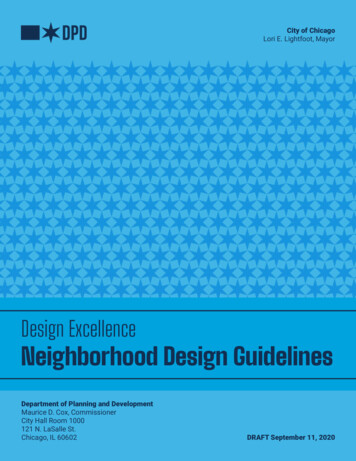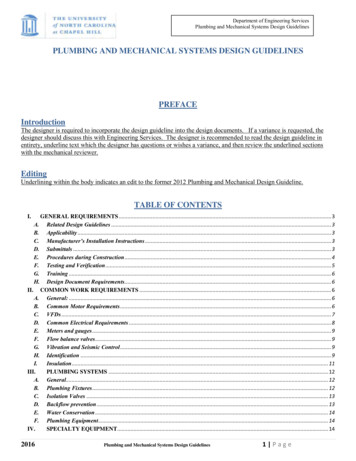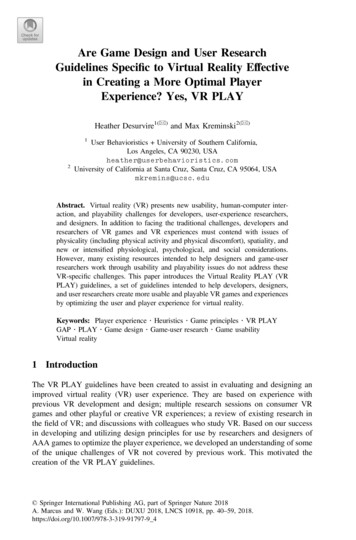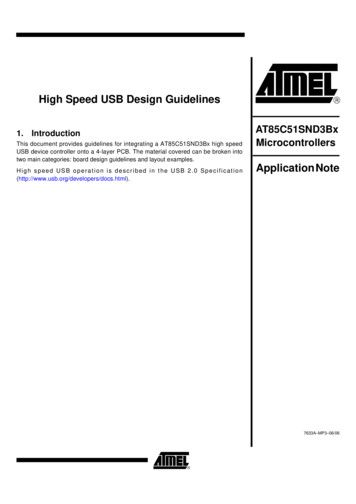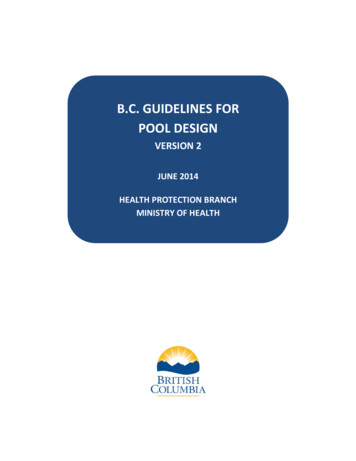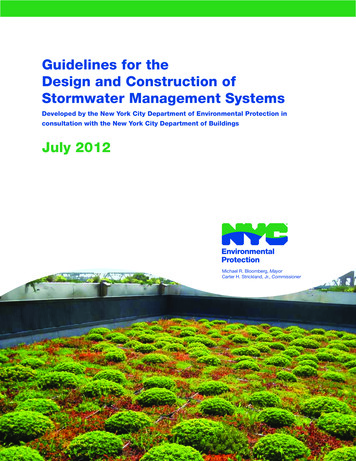
Transcription
Guidelines for theDesign and Construction ofStormwater Management SystemsDeveloped by the New York City Department of Environmental Protection inconsultation with the New York City Department of BuildingsJuly 2012Michael R. Bloomberg, MayorCarter H. Strickland, Jr., Commissioner
Cover: An extensive green roof system installed atop the NYC Department of Parks and Recreation’s (DPR) Five BoroughBuilding on Randall’s Island. This modular system is one of six variations installed on the roof and covers 800 square feet, consisting of two-foot by two-foot trays with six inches of mineral soil and over 1,500 sedum plugs. DPR has installed 25 greenroof systems covering over 29,000 square feet on the Five Borough Building rooftop to feature different types and depths ofgrowing medium and plant selection.
Dear Friends;The NYC Green Infrastructure Plan, released in September 2010, proposed an innovative approach for cost-effective and sustainable stormwater management. A major part of this plan isour commitment to manage the equivalent of an inch of rainfall on ten percent of the imperviousareas in combined sewer watersheds by 2030. To that end, DEP is prepared to spend 1.5 billion to construct green infrastructure projects across the city. Yet public investment alone will notachieve our water quality goals, or our desired recreation and development opportunities.Some of the most cost-effective opportunities are represented by new construction and development, when stormwater source controls can be easily included in designs and built at a fraction of the cost of retrofitting existing buildings. DEP initiated a citywide rulemaking process andworked closely with development, labor, and environmental organizations over two years.In response to suggestions received in that process, DEP worked with the Department of Buildings to develop an informative guidance document to accompany the rule. The informationcontained in this document will ease the development community’s transition to stricter stormwater release rates when connecting to the City’s combined sewer system. These guidelineswill continue to evolve as we learn more from our pilot projects and as stormwater regulationschange. We welcome feedback about the structure and content of this document.Together we are proud to say that New York City has taken a critical step toward furtherimproving harbor water quality and making our city greener and greater than ever before.Sincerely,Carter H. Strickland, Jr.Commissioner
TABLE OF CONTENTS 5Table of Contents1 Introduction. 11.1 Purpose and Scope of Document . 21.2 Stormwater Management in New York City. 41.3 City Development and Review Process . 71.4 Types of Stormwater Management Systems . . 91.5 Selecting an Appropriate System. 121.6 Responsibilities of the Licensed Professional and Property Owner. 121.7 Document Organization. 132 Sizing Stormwater Management Systems. 152.1 Calculating Developed Site Flow and Runoff Coefficients. 162.2 Determining the Release Rate, Storage Volume, and Storage Depth. 172.3 Subsurface System Sizing Calculations. 172.3.1 Sizing Vault Systems. 172.3.2 Sizing Gravel Bed Systems. 172.3.3 Sizing Perforated Pipe Systems. 192.3.4 Sizing Stormwater Chamber Systems. 212.4 Rooftop System Sizing Calculations. 252.4.1 Sizing Blue Roof Systems. 262.4.2 Sizing Green Roof Systems. 282.5 Storage Volume Reduction Calculations. 302.5.1 Determining Volume Reduction from Infiltration. 302.5.2 Determining Volume Reduction from Recycling. 312.6 Sizing Combination Systems. 322.6.1 Calculate the Release Rate. 332.6.2 Determine Available Storage Volume on Roof. 332.6.3 Calculate Effective Runoff Coefficient. 332.6.4 Calculate the Required Volume for the Subsurface System. 34i
5 TABLE OF CONTENTS3 Subsurface Systems. 353.1 Types of Subsurface Systems. 363.1.1 Storage Vaults and Tanks . 363.1.2 Gravel Beds. 373.1.3 Perforated Pipes. 373.1.4 Stormwater Chambers. 383.2 Siting Considerations for Subsurface Systems. 383.2.1 Soil, Bedrock, and the Water Table. 393.2.2 Buffers and Setbacks. 393.2.3 Utility Considerations. 393.2.4 System Configuration. 423.3 Subsurface System Design. 443.3.1 Inlets and Drains. 443.3.2 Pretreatment. 453.3.3 Outlet Control Structure. 473.3.4 Observation Well. 483.3.5 Materials. 483.3.6 Surface Loading. 483.3.7 Climate Considerations. 493.4 Subsurface System Construction. 523.4.1 Pre-Construction Meeting. 523.4.2 Soil Excavation, Field Testing, and Disposal Excavation. 523.4.3 Installation of Subsurface Systems. 543.4.4 Construction Inspections and As-Built Certification. 593.5 Operations and Maintenance for Subsurface Systems. 603.5.1 Post-Construction Monitoring (First Year). 603.5.2 Inspections. 603.5.3 Maintenance. 613.5.4 Developing an Inspection and Maintenance Plan. 633.5.5 Troubleshooting. 64ii
TABLE OF CONTENTS 54 Rooftop Systems. 674.1 Types of Rooftop Systems. 684.1.1 Blue Roofs. 684.1.2 Green Roofs. 684.2 Siting Considerations for Rooftop Systems. 704.2.1 Site and Building Characterization. 704.2.2 Complementary Uses. 724.2.3 Considerations for Multiple Roof Levels. 734.3 Rooftop System Design. 744.3.1 Roof Assemblies and Materials. 744.3.2 Waterproofing Membrane. 754.3.3 Leak Detection Systems. 774.3.4 Roof Drains and Scuppers. 784.3.5 Roof Slope, Ponding Depth, and Drainage Configurations. 794.3.6 Growing Media and Vegetation. 804.3.7 Loadings and Structural Capacity. 844.3.8 Climate Considerations. 854.4 Rooftop System Construction. 864.4.1 Pre-Construction Meeting. 864.4.2 Waterproofing System. 874.4.3 Installation of Controlled Flow Drains. 874.4.4 Installation of Green Roof Systems. 884.4.5 Construction Inspections and As-Built Certification. 934.5 Operations and Maintenance for Rooftop Systems. 954.5.1 Post-Construction Monitoring. 954.5.2 Inspections. 954.5.3 Maintenance. 964.5.4 Developing an Inspection and Maintenance Plan. 984.5.5 Troubleshooting. 985 Combination Systems. 1015.1 Combination Rooftop and Subsurface Systems. 1025.2Impervious Surface Reductions and Rainwater Recycling. 102iii
5 TABLE OF CONTENTSReferences and ResourcesAcknowledgementsAppendix A GlossaryAppendix B Applicable Stormwater Codes and Regulatory RequirementsAppendix C Required Submittals for DEP and DOB CertificationAppendix D City Permitting ProcessesAppendix E Recommended Planting List for Porous Infiltration PracticesAppendix F Recommended Planting List for Green RoofsAppendix G Variables Used in Sizing of Stormwater Management SystemsAppendix H Soil Evaluations for Porous Infiltration PracticesAppendix IPermeability Test ProcedureAppendix J Acronymsiv
Section 1IntroductionThe New York City Department of Environmental Protection (DEP) is responsiblefor the city’s drainage plan and stormwatermanagement. Through DEP approval of sewer certifications (approval that the City sewer can accept the proposed discharge) andsubsequent sewer connection permits (authorization to connect to a sewer), DEP limitsthe “allowable flow” from development lots toprovide adequate capacity in the sewer system based on sewer design criteria.Recently, DEP has revised its stormwaterrules for new development and redevelopment in combined sewer areas. The newperformance standard is intended to reducepeak discharges to the city’s sewer systemduring rain events by requiring greater onsite storage of stormwater runoff and slower release to the sewer system. The implementation of DEP’s stormwater performancestandard over time is expected to provideadditional capacity to the existing sewer system, thereby improving its performance. Theperformance standard is a key element of theNew York City Green Infrastructure Plan (the“NYC Green Infrastructure Plan”) to promotegreen infrastructure and improve water quality in the city’s surrounding waterbodies.Native beds established on the green roof at DPR’s FiveBorough Building on Randall’s Island.
1 INTRODUCTION1.1 Purpose andScope of DocumentDEP’s stormwater performance standard is intended to reduce adverse impacts on the city’scombined sewer system from runoff during rainstorms that are more severe than sewers andrelated facilities are designed to handle. Whenexcessive stormwater enters the combinedsewer system from impervious surfaces, it cancause combined sewer overflows (CSOs), flooding, and sewer backups. By slowing the flow ofstormwater to the sewers, the stormwater performance standard allows the city to managestormwater runoff from new development andredevelopment more effectively and maximize,to the greatest extent possible, the capacity ofthe city’s combined sewer systems.These guidelines were developed by DEP, inconsultation with the New York City Department of Buildings (DOB), to provide guidanceto New York City’s development community andlicensed professionals for the planning, designand construction of onsite source controls thatcomply with DEP’s stormwater performancestandard. The stormwater performance standardwas promulgated on [DATE] as an amendmentto Chapter 31 of Title 15 of the Rules of the Cityof New York, Rule Governing House/Site Connections to the Sewer System Standards forRelease Rates (“Chapter 31”). These guidelinesreflect the requirements of these rules and theNew York City Construction Codes (“Construction Codes”), as administered by DOB.While these guidelines are provided to assistthe development community, licensed professionals always maintain the responsibility tosubmit acceptable designs in accordance withall applicable laws, rules, and regulations andproperty owners are responsible for maintaining onsite constructed systems.2Stormwater Performance StandardSection 3 of Chapter 31 was revised to includethe Stormwater Performance Standard for Connections to Combined Sewer System (“stormwater performance standard”). As a result, thefollowing requirement applies to proposed developments that require a New Building permitfrom DOB (“new development”) in combinedsewer areas of the city:The Stormwater Release Rate must be nomore than the greater of 0.25 cfs or 10% ofthe Allowable Flow or, if the Allowable Flowis less than 0.25 cfs, no more than the Allowable Flow.For proposed redevelopments in combinedsewer areas of the city, the following requirement applies to “alterations,” as defined in theConstruction Codes and related requirements,for any horizontal building enlargement or anyproposed increase in impervious surfaces:The Stormwater Release Rate for the alteredarea must be no more than the stormwaterrelease rate for the entire site, determined inaccordance with the requirement above, multiplied by the ratio of the altered area to thetotal site area. No new points of dischargeare permitted.The EPA andGreen InfrastructureThe United States Environmental Protection Agency (EPA) suggests that the useof green infrastructure “can be a costeffective, flexible, and environmentallysound approach to reduce stormwaterrunoff and sewer overflows and to meetClean Water Act (CWA) requirements.Green infrastructure also provides a variety of community benefits includingeconomic savings, green jobs, neighborhood enhancements and sustainablecommunities” (EPA, 2011).
INTRODUCTION 1Figure 1-1:Stormwater chamberswere installed priorto filling with soil forthe construction of aconstructed wetland at aDOT parking lot in FarRockaway. The wetlandarea, to be planted inSpring 2012, will allowrunoff to infiltrate directlyinto the subsurface system. The adjacent parkinglot is paved with porouspavement and excess flowwill be directed to theconstructed wetland.The new stormwater performance standard effectively applies to new development and alterations on medium to large size lots. Smallerdevelopment sites generally do not generaterunoff in excess of 0.25 cfs and, therefore, areexpected to comply with current requirementsconcerning the Allowable Flow and storage volume requirements, sewer availability, and theconnection application process.DEP allows for different types of stormwatermanagement systems to comply with the stormwater performance standard, including subsurface, rooftop and stormwater recycling systems.These systems store and slowly release stormwater to the sewer system (detention) or disposeof stormwater onsite (retention) through infiltration to soils below, evapotranspiration, and recycling onsite.For specific systems, compliance with the following requirements allows for required detention volumes to be reduced:For proposed open-bottom detention systems, DEP will consider requests for reduction of the required stormwater volume to bedetained where stormwater will be infiltratedinto the below soils. Such requests must besubstantiated by soil borings taken at thelocation of the proposed system in additionto a permeability test performed in situ todemonstrate that the existing soil surrounding and below the system has a favorablerate of permeation. Requests for any volumecredits must be shown on the site connectionproposal application and reviewed by DEP.DEP will consider requests for reduction ofthe required stormwater volume to be detained where stormwater will be recycled foron-site uses. The recycling system shall beindependent and shall not result in total sitedischarge to the sewer system greater thanthe Stormwater Release Rate at any time.Such recycling systems cannot be modifiedor disconnected, with
Cover: An extensive green roof system installed atop the NYC Department of Parks and Recreation’s (DPR) Five Borough Building on Randall’s Island. This modular system is one of six variations installed on the roof and covers 800 square feet, con-sisting of two-foot by two-foot trays wi
